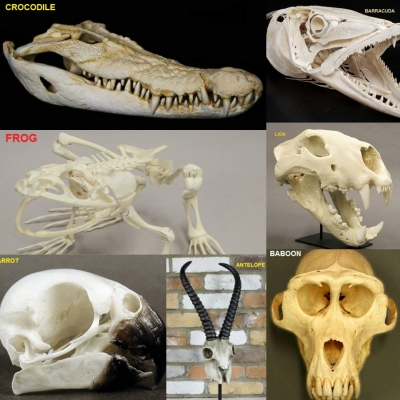
SKULLS
Most vertebrates (animals with backbones) have strong bony skulls. They are made up of cranial bones that protect their brains, jaw bones that support their teeth or beaks, and face bones that contain their eye sockets and nasal cavities. The whole structure can be quite heavy, and is supported by strong neck muscles.
- CROCODILE One of the closest living relatives of the dinosaurs, crocodiles has long jaws studded with many sharp-pointed teeth for seizing their prey. The fish-eating gharial of Indian rivers may have more than 100 teeth.
- PARROT All birds have thin, light skulls, which make flying easier. Their beaks or bills are much lighter than toothed jaws. They are not built for chewing, yet the bills of some parrots are strong enough to crack nuts.
- FROG The skull of a frog is broad, providing plenty of room for its large eyes and giving it an extremely wide mouth. This allows it to swallow its prey whole, so it does not need a set of teeth for chewing.
- LION Like all cats, the lion is a dedicated hunter. It has short, powerful jaws with huge stabbing canine teeth at the front, and meat-slicing carnassials at the back.
- ANTELOPE Some animals, such as antelope and cattle, have massive horns on their heads for defence and fighting rivals. Male deer grow antlers, which they use to impress females and fight each other, but these antlers fall off at the end of the mating season. Each male grows a new pair every year.
- BARRACUDA Fish have quite strong skulls, but the various parts are not fused together like those of mammals. The jaws of many fish are separate from the brain case, but attached by bones that allow them to be thrust forward to seize prey.
- BABOON Close relatives of humans, baboons have similar skulls, but longer jaws and bigger back teeth. This is because they eat large quantities of grass, which requires a lot of chewing. They also have long, sharp canines, which they use to kill animals for food, and to fight among them. Baboon Eye sockets at front of skull allows the baboon to see things in three dimensions.
Picture Credit : Google



